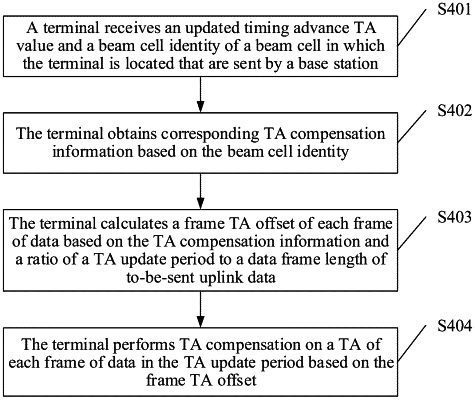| CPC H04W 56/005 (2013.01) [H04W 56/0035 (2013.01); H04W 56/009 (2013.01); H04W 84/06 (2013.01)] | 17 Claims |

|
1. A timing advance update method, comprising:
receiving, from a base station and by a terminal, an updated timing advance (TA) value and a beam cell identity of a beam cell in which the terminal is located;
obtaining, by the terminal, TA compensation information based on the beam cell identity, wherein the TA compensation information comprises reference data, wherein the reference data. comprises a maximum TA offset and a minimum transmission delay TA offset of a current beam cell, and the reference data comprises a satellite orbital altitude of a satellite and geocentric angle data of the current beam cell, wherein the geocentric angle data comprises a maximum geocentric angle and a minimum geocentric angle, and wherein the terminal obtains, based on the geocentric angle data and the satellite orbital altitude a round-trip transmission delay change rate of a location corresponding to the geocentric angle data according to the following formula:
 wherein
T′α represents the round-trip transmission delay change rate of the location corresponding to the geocentric angle data, c represents a speed of light, ω represents a relative angular velocity between the satellite and a user, R represents an Earth radius, h represents the satellite orbital altitude, and θ represents the geocentric angle data;
performing, by the terminal, TA compensation in a TA update period based on the updated TA value and the TA compensation information; and
sending, by the terminal, uplink data by using a TA value obtained after TA compensation is performed.
|